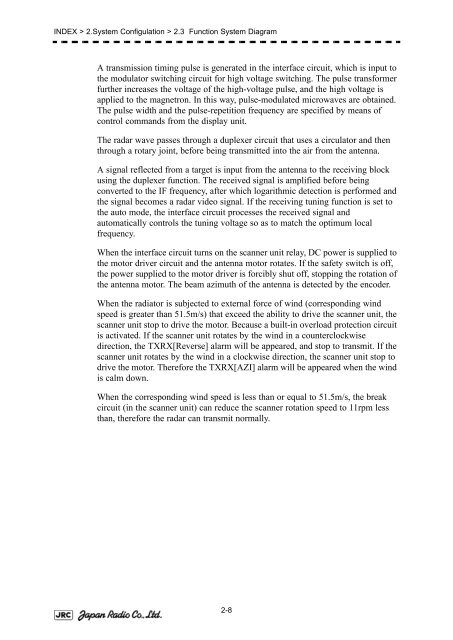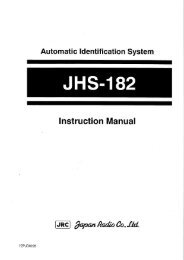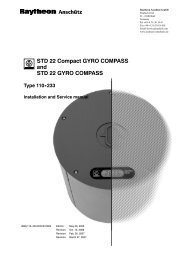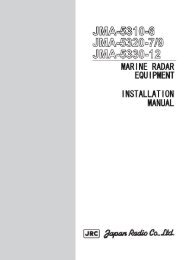- Page 1: JMA-5332-12 JMA-5322-7/9/6HS JMA-53
- Page 4 and 5: 3.1.3 Circuit Block to be Repaired
- Page 6 and 7: 6. Troubleshooting 6.1 Operation Te
- Page 8 and 9: 7.3 Terminal Board Connection Diagr
- Page 11 and 12: INDEX > 1.System Overview > 1.1 Ove
- Page 13 and 14: INDEX > 1.System Overview > 1.3 Dis
- Page 15 and 16: Section 2 System Configulation 2.1
- Page 17 and 18: INDEX > 2.System Configulation > 2.
- Page 19 and 20: INDEX > 2.System Configulation > 2.
- Page 21 and 22: INDEX > 2.System Configulation > 2.
- Page 23: INDEX > 2.System Configulation > 2.
- Page 27 and 28: INDEX > 2.System Configulation > 2.
- Page 29 and 30: INDEX > 2.System Configulation > 2.
- Page 31 and 32: INDEX > 2.System Configulation > 2.
- Page 33 and 34: INDEX > 2.System Configulation > 2.
- Page 35 and 36: INDEX > 2.System Configulation > 2.
- Page 37 and 38: INDEX > 2.System Configulation > 2.
- Page 39 and 40: INDEX > 2.System Configulation > 2.
- Page 41 and 42: INDEX > 2.System Configulation > 2.
- Page 43: Section 3 Repair Parts 3.1 List of
- Page 46 and 47: INDEX > 3.Repair Parts > 3.1 List o
- Page 48 and 49: INDEX > 3.Repair Parts > 3.1 List o
- Page 50 and 51: INDEX > 3.Repair Parts > 3.2 Illust
- Page 52 and 53: INDEX > 3.Repair Parts > 3.2 Illust
- Page 54 and 55: INDEX > 3.Repair Parts > 3.2 Illust
- Page 56 and 57: INDEX > 3.Repair Parts > 3.2 Illust
- Page 58 and 59: INDEX > 3.Repair Parts > 3.2 Illust
- Page 60 and 61: INDEX > 3.Repair Parts > 3.2 Illust
- Page 62 and 63: INDEX > 3.Repair Parts > 3.2 Illust
- Page 64 and 65: INDEX > 3.Repair Parts > 3.2 Illust
- Page 66 and 67: INDEX > 3.Repair Parts > 3.2 Illust
- Page 68 and 69: INDEX > 3.Repair Parts > 3.2 Illust
- Page 70 and 71: INDEX > 3.Repair Parts > 3.2 Illust
- Page 72 and 73: 4.2.17 Performance Monitor replacem
- Page 74 and 75:
INDEX > 4.Replacement Procedure > 4
- Page 76 and 77:
INDEX > 4.Replacement Procedure > 4
- Page 78 and 79:
INDEX > 4.Replacement Procedure > 4
- Page 80 and 81:
INDEX > 4.Replacement Procedure > 4
- Page 82 and 83:
INDEX > 4.Replacement Procedure > 4
- Page 84 and 85:
INDEX > 4.Replacement Procedure > 4
- Page 86 and 87:
INDEX > 4.Replacement Procedure > 4
- Page 88 and 89:
INDEX > 4.Replacement Procedure > 4
- Page 90 and 91:
INDEX > 4.Replacement Procedure > 4
- Page 92 and 93:
INDEX > 4.Replacement Procedure > 4
- Page 94 and 95:
INDEX > 4.Replacement Procedure > 4
- Page 96 and 97:
INDEX > 4.Replacement Procedure > 4
- Page 98 and 99:
INDEX > 4.Replacement Procedure > 4
- Page 100 and 101:
INDEX > 4.Replacement Procedure > 4
- Page 102 and 103:
INDEX > 4.Replacement Procedure > 4
- Page 104 and 105:
INDEX > 4.Replacement Procedure > 4
- Page 106 and 107:
INDEX > 4.Replacement Procedure > 4
- Page 108 and 109:
INDEX > 4.Replacement Procedure > 4
- Page 110 and 111:
INDEX > 4.Replacement Procedure > 4
- Page 112 and 113:
INDEX > 4.Replacement Procedure > 4
- Page 114 and 115:
INDEX > 4.Replacement Procedure > 4
- Page 116 and 117:
INDEX > 4.Replacement Procedure > 4
- Page 118 and 119:
INDEX > 4.Replacement Procedure > 4
- Page 120 and 121:
INDEX > 4.Replacement Procedure > 4
- Page 122 and 123:
INDEX > 4.Replacement Procedure > 4
- Page 124 and 125:
INDEX > 4.Replacement Procedure > 4
- Page 126 and 127:
INDEX > 4.Replacement Procedure > 4
- Page 128 and 129:
INDEX > 4.Replacement Procedure > 4
- Page 130 and 131:
INDEX > 4.Replacement Procedure > 4
- Page 132 and 133:
INDEX > 4.Replacement Procedure > 4
- Page 134 and 135:
INDEX > 4.Replacement Procedure > 4
- Page 136 and 137:
INDEX > 4.Replacement Procedure > 4
- Page 138 and 139:
INDEX > 4.Replacement Procedure > 4
- Page 140 and 141:
INDEX > 4.Replacement Procedure > 4
- Page 142 and 143:
INDEX > 4.Replacement Procedure > 4
- Page 144 and 145:
INDEX > 4.Replacement Procedure > 4
- Page 146 and 147:
INDEX > 4.Replacement Procedure > 4
- Page 148 and 149:
INDEX > 4.Replacement Procedure > 4
- Page 150 and 151:
INDEX > 4.Replacement Procedure > 4
- Page 152 and 153:
INDEX > 4.Replacement Procedure > 4
- Page 154 and 155:
INDEX > 4.Replacement Procedure > 4
- Page 156 and 157:
INDEX > 4.Replacement Procedure > 4
- Page 158 and 159:
INDEX > 4.Replacement Procedure > 4
- Page 160 and 161:
INDEX > 4.Replacement Procedure > 4
- Page 162 and 163:
INDEX > 4.Replacement Procedure > 4
- Page 165 and 166:
INDEX > 5.Updating Programs > 5.1 M
- Page 167 and 168:
INDEX > 5.Updating Programs > 5.3 V
- Page 169 and 170:
Section 6 Troubleshooting 6.1 Opera
- Page 171:
6.6.3 Blurry image on the remote di
- Page 174 and 175:
INDEX > 6.Troubleshooting > 6.1 Ope
- Page 176 and 177:
INDEX > 6.Troubleshooting > 6.1 Ope
- Page 178 and 179:
INDEX > 6.Troubleshooting > 6.1 Ope
- Page 180 and 181:
INDEX > 6.Troubleshooting > 6.2 Sca
- Page 182 and 183:
INDEX > 6.Troubleshooting > 6.2 Sca
- Page 184 and 185:
INDEX > 6.Troubleshooting > 6.2 Sca
- Page 186 and 187:
INDEX > 6.Troubleshooting > 6.2 Sca
- Page 188 and 189:
INDEX > 6.Troubleshooting > 6.2 Sca
- Page 190 and 191:
INDEX > 6.Troubleshooting > 6.2 Sca
- Page 192 and 193:
INDEX > 6.Troubleshooting > 6.3 Dis
- Page 194 and 195:
INDEX > 6.Troubleshooting > 6.3 Dis
- Page 196 and 197:
INDEX > 6.Troubleshooting > 6.3 Dis
- Page 198 and 199:
INDEX > 6.Troubleshooting > 6.3 Dis
- Page 200 and 201:
INDEX > 6.Troubleshooting > 6.3 Dis
- Page 202 and 203:
INDEX > 6.Troubleshooting > 6.4 Err
- Page 204 and 205:
INDEX > 6.Troubleshooting > 6.4 Err
- Page 206 and 207:
INDEX > 6.Troubleshooting > 6.4 Err
- Page 208 and 209:
INDEX > 6.Troubleshooting > 6.4 Err
- Page 210 and 211:
INDEX > 6.Troubleshooting > 6.4 Err
- Page 212 and 213:
INDEX > 6.Troubleshooting > 6.4 Err
- Page 214 and 215:
INDEX > 6.Troubleshooting > 6.5 Sam
- Page 216 and 217:
INDEX > 6.Troubleshooting > 6.5 Sam
- Page 218 and 219:
INDEX > 6.Troubleshooting > 6.5 Sam
- Page 220 and 221:
INDEX > 6.Troubleshooting > 6.6 Ext
- Page 222 and 223:
INDEX > 6.Troubleshooting > 6.6 Ext
- Page 224 and 225:
7.3 Terminal Board Connection Diagr
- Page 226 and 227:
INDEX > 7.Drawings > 7.1 Outline Dr
- Page 228 and 229:
INDEX > 7.Drawings > 7.1 Outline Dr
- Page 230 and 231:
INDEX > 7.Drawings > 7.1 Outline Dr
- Page 232 and 233:
INDEX > 7.Drawings > 7.1 Outline Dr
- Page 234 and 235:
INDEX > 7.Drawings > 7.1 Outline Dr
- Page 236 and 237:
INDEX > 7.Drawings > 7.1 Outline Dr
- Page 238 and 239:
INDEX > 7.Drawings > 7.1 Outline Dr
- Page 240 and 241:
INDEX > 7.Drawings > 7.2 General Sy
- Page 242 and 243:
INDEX > 7.Drawings > 7.3 Terminal B
- Page 244 and 245:
INDEX > 7.Drawings > 7.3 Terminal B
- Page 246 and 247:
6 4 2 1 INDEX > 7.Drawings > 7.4 In
- Page 248 and 249:
5 2 4 1 INDEX > 7.Drawings > 7.4 In
- Page 250 and 251:
INDEX > 7.Drawings > 7.4 Internal c
- Page 252 and 253:
INDEX > 7.Drawings > 7.4 Internal c
- Page 254 and 255:
INDEX > 7.Drawings > 7.5 Circuit Sc
- Page 256 and 257:
INDEX > 7.Drawings > 7.5 Circuit Sc
- Page 258:
INDEX > 7.Drawings > 7.5 Circuit Sc






